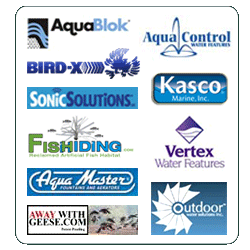Home > Types of Lakes and Ponds > Industrial and Waste Water Ponds
Industrial & Wastewater Ponds
Cooling Ponds - Holding Ponds - Process Ponds - Fire Ponds - Wastewater Ponds

Wastewater ponds (sewage stabilization and retention ponds) are essential for the processing of nutrient-rich effluent wastes of civilization and agricultural stock. The complex series of interaction of microorganisms and the exposure to sunlight and atmospheric gas exchange all play an important part in the successful degradation of these wastes. The bound nutrients initially present and the subsequent release of additional nutrients through organic decay can cause severe overpopulation and/or fluctuations in aquatic species present.
Aquatic plants can be a friend or foe in sewage stabilization and retention ponds. Balanced populations serve a function in nutrient removal and oxygenation. However, severe algal blooms, common to these effluent waters, can create serious water quality problems. Violations of discharge standards that can be directly attributed to excess algal growth often occur. These can include exceeding limits for suspended solids, BOD, and pH within discharge water. Rooted and floating plants within lagoons can impair clarification, settling and water flow, plus reduce holding capacity. Aquatic plant management is required to keep these systems operating legally and efficiently.
DISTRIBUTOR




